The Captain Thomas Robinson Burial Ground
(1785-1904) Broad Street,Stonington Borough By Mary M. Thatcher and James Boylan
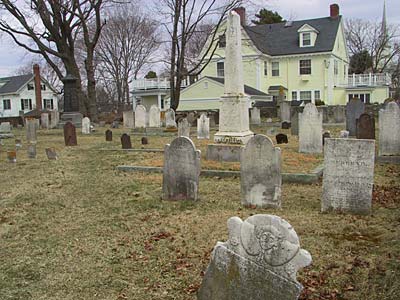
In 1771 Captain Thomas Robinson, an English mariner, bought 11 acres of land on Long Point (now known informally as Stonington Point) from Elihu Chesebrough. The Robinson Pasture, as it was called, ran from what is now the corner of Main Street and High Street west to Stonington Harbor, and north to the Dodson Boatyard. It was and is the only burial ground on Long Point.
Captain Robinson built his house at the northwest corner of High and Northwest streets. He sold house lots on the southern bound of his pasture, and began to use one lot at the northern end of his lane (later Gold Street) as a burial place for his family and a few friends.
The burial ground was expanded in 1785 when he sold lots to Isaac Sheffield, Ebenezer Cobb, Sands Niles, William Fellows, Peleg Brown, Nathaniel Hall, Andrew Brown, and Gilbert Fanning. In 1792 he sold a lot in the northeast corner to the newly widowed Louisa Fox Holmes, and another to Captain Robert Palmer. All the owners had the right of passage over the lane from High Street.
During the Battle of Stonington, August 10 through 13, 1814, a British bombshell landed in the yard, creating a large crater, which served as the site of an unusual burial. Huldah Hall was caring for her dying mother, Elisabeth, in their house on Trumbull Street, just behind the fort from which the defenders were firing their cannon. When her mother died, she was hastily carried to the yard on her bed and bed and body were buried in the crater. Huldah died after 1830, and was also buried here, but because she was very poor there was no marker for her grave. In 1900 the Children of the American Revolution erected the monument in her memory.
The families here represent late 18th-century Stonington -- sea captains, merchants, carpenters, hatters, tailors, schoolteachers, a postmaster, a customs collector. They were members of the Baptist and Congregational churches. Two of the people in this yard appear in the book on Connecticut divorces for New London County. Some died at sea or in distant lands, many at home; two died of apoplexy, one at a funeral, another at a political meeting. Many died in infancy, some very old. And as is the way in small communities, most were connected by blood or marriage.
The first stone encountered as you enter the yard is that of Captain Thomas Robinson, who died when his ship, the Dove, was wrecked off Point Judith, Rhode Island, on 26 October 1793. It is the work of the Manning family of gravestone carvers, and there are several other stones by this family. The undated stone of four Robinson children is most touching.
For more information on graveyards,visit:
The Association for Gravestone Studies at www.gravestonestudies.org
Saving Graves at www.savinggraves.com
The Connecticut Gravestone Network at
http://members.aol.com/ctgravenet/index.htm
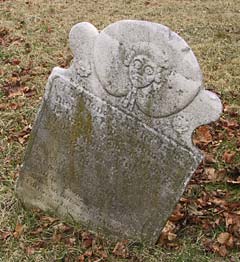
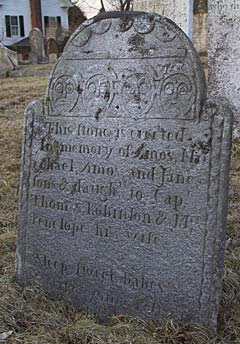
The stones are missing for many members of the immediate family of Thomas Robinson. There is no stone for his widow, Penelope, or for their sons Michael and Thomas, or their wives. Joseph P. Cutler, ship's carpenter, was the husband of Jane Robinson, granddaughter of Captain Thomas. It is fitting that the last burial in this yard was that of Samuel Clark, captain of the sealing vesselThomas Hunt, who was married to the Cutlers' daughter Lucretia.
Not to be missed are the monuments to the Fanning family (Edmund Fanning circumnavigated the globe in 1798), the Fellows family (William Fellows was a ship's carpenter), and the Sheffield brothers, Isaac and Acors. Isaac was a successful merchant; Acors led Stonington troops during the Revolution; and Isaac's stepson Sylvester Pendleton commanded the privateer Hornet. Amos, Isaac's son, was in the Caribbean trade and died at Demerara, Guyana.
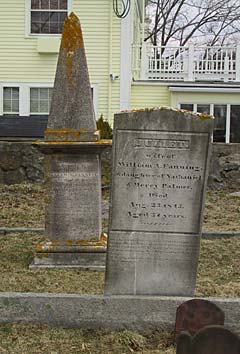
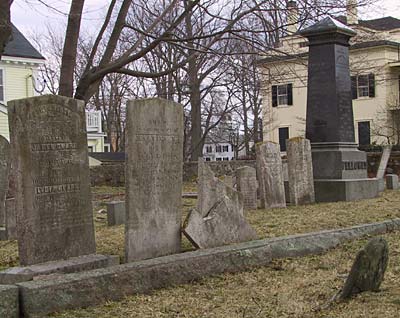
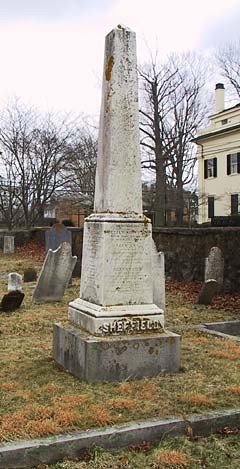
Jonathan Palmer was Stonington's first postmaster and its first customs collector.
Captain Peleg Brown was a shipwright and the grandfather of Captain Nathaniel Brown Palmer, who discovered Antarctica in 1821, and whose house, a National Historic Landmark, is owned and operated by the Stonington Historical Society. (For more information on the Palmer house, please click here.)
The Cobbs were related through marriage to many Stonington families.
Abraham Loper was the father of Richard Fanning Loper, who provided ships to the United States Navy in the Mexican War (1846-48).
Sands Niles was a stern schoolmaster and the secretary for the Stonington Borough Baptist Church.
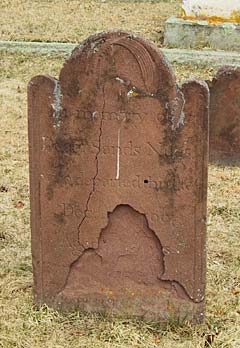
The crude fieldstones marked "TH" and "DHH" (Thomas Hall and Daniel Hobart Hall) are the father and son of Nathaniel Hall, who moved to New York state, as did Andrew Brown.
The stone of Thomas Robson, son of William and Susannah, poses a mystery: the stone, of green Newport slate, is by the John Stevens workshop of Newport, Rhode Island, but Robson has not been identified.
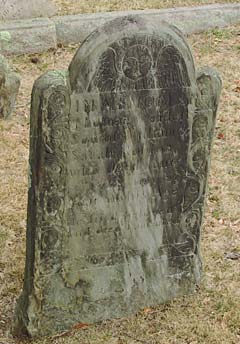
Caring for the Robinson Burial Ground
Few of the families whose ancestors are found in the Robinson Burial Ground still have descendents living in the Stonington area. The Lydia Fellows Langworthy Chesebro endowment for the care of the cemetery was eventually depleted, and John Dodge, a descendant of Anne Cutler Atwood, gave money annually for its maintenance. After his death, the burial ground was neglected and overgrown. A concerned neighbor, John Scarborough, undertook to raise funds for its restoration.
Since 1991 the Borough of Stonington's Highway Department regularly mows and maintains the yard. However, additional funds are needed for care and maintenance of the tombstones.
The Stonington Historical Society plans to publish a complete history of the yard and of those buried there, including transcriptions of the wording on the stones, now fading beyond legibility.
The Stonington Historical Society hopes that visitors to the Robinson Burial Ground, and everyone interested in protecting and preserving this irreplaceable evidence of Stonington's early-American heritage, will be willing to help. Donations for the upkeep of the Robinson Burial Ground may be sent to the Robinson Cemetery Fund, c/o the Stonington Historical Society, P O Box 103, Stonington CT 06378.
Text adapted from a brochure prepared for the Stonington Historical Society by Mary M. Thacher and James Boylan in October 1999.